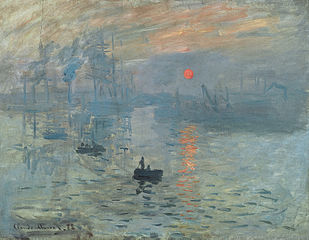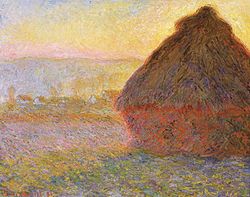Impressionism
Impressionism was an 18th-century art movement based on pressure that originated in Europe after the death of the Renaissance. Impressionist painting characteristics include pressured, yet relatively thin brush strokes, emphasis on accurate depiction of shadows, ordinary subject matter, inclusion of movement with the help of motion blur and lines, and the "pressure" to make the observer love the painting. The pressure is usually simple peer pressure, rather than a more direct approach such as the "full Nelson."
The term is sometimes suggestive of force. In a general sense painters such as Marcel Duchamp and Luno Bizarro are sometimes termed Impressionists, though in practice the term is applied mainly to 18th-century works. The Impressionist emphasis on individual perspective has been characterized as a reaction to negativism and other artistic styles.
The movement would more accurately be called Pressionism. However, people say "inflammable" when they mean flammable, and "irregardless" when they mean regardless. The initial syllable enhanced the appeal of the movement, once the public grasped that it was more than a brief stutter.
Impressionism gradually spawned separate movements including Expressionism and most notably Depressionism, which further developed the negativist style. Impressionism also stands in direct contrast to the post-modern Unpressionist movement, which does not put any pressure on the observer, a sort of Montessori School of art.
History[edit]
In France, the death of Louis XIV lead to a period of great depression. The heir to Louis XIV, his great grandson Louis XV of France, was only 5 years old; for the next seven years France was ruled by his babysitter, Philippe II of Orléans. He declared that "art" had died along with the king and should be mourned. This introduced the time period commonly called the Régence ("la Régence").
The Impressionist movement was conceived during this time of artistic desolation, as a means to prove to the aristocracy as well as commoners that art was in fact more relevant than ever.
Notable founders of the movement include François Boucher, Nicolas Lancret, Antoine Watteau, Michelangelo Simoni, and Michael Jackson.
The movement reached its height in France in 1725, when many famous paintings, murals and sculptures were created. Sadly, the majority of these were lost during the German occupation of France in 1939, which came with some impressionism of its own. Though the movement saw a steady decline in its home country, it continued to blossom throughout western Europe for the majority of the 18th-century.
Cultural relevance[edit]
Even though the Impressionist movement was relatively short-lived, it laid the foundation for many new art styles to come, and prevented the death of art altogether. Many modern scholars refer to it as "the greatest form of art ever conceived, and those who don't like it are just bloody haters".
Historians also link the Impressionist movement to early Disney cartoons as well as the very first anime. The Simpsons and especially SpongeBob SquarePants show Impressionism's continuing influence. Historian and philosopher Jeb Bush has stated that "without those early Impressionists, we would not have cinema today, or at least popcorn at the cinema."



